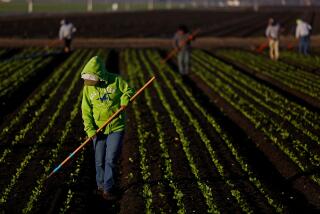World Gets More to Eat, Africa Gets Less Than Ever : Hunger: Agricultural fertility can’t keep up with human fertility; the entire continent now subsists on handouts.
- Share via
HELSINGOR, Denmark — War in Africa has been a primary cause and exacerbater of famine. But don’t make the mistake of thinking that, because in the last few days the wars in Angola and Ethiopia have been wrapped up, the great hunger stories are over. Africa’s agricultural problems are just too severe, its climate too harsh and erratic, its soils too poor, its governments too mismanaged and its population growth out of control, for any imminent solution to be on the horizon, or even over it.
This weekend, here in Hamlet’s home town, agricultural ministers from most of the world’s countries are holding their annual get-together under the auspices of the United Nations’ World Food Council.
The report they have been given on the state of agriculture in Africa was the most devastatingly pessimistic document I’ve heard or read for a long time. Anyone who was dreaming, as I was, that there are hopeful signs got a rude shock. Yes, I’ve seen how Zimbabwe has geared up its peasant small-holders to the point where they produce sizeable export surpluses year after year. I’ve watched, and been inspired by, the technical wizardry of anti-pest programs sponsored by the International Fund for Agricultural Development; they have knocked down the screw worm, which threatens livestock, and the mealy bug, which was eating its way through the continent’s main food staple, cassava. None of this--or all the other bits and pieces of progress--seems to have made a dent in the macro-statistics.
The last 20 years have shown beyond a shadow of doubt that Africa has the highest average increase in population in the world and the least productive growth in food output. While it’s true that the number of poor and hungry is rising in all Third World countries, in Asia the increase in numbers--an extra 10 million since 1970--is minuscule compared with the successful feeding of the hundreds of millions of extra mouths that weren’t around 20 years ago. In Africa, a much less heavily populated continent, the number of hungry has increased in that time from 92 million to more than 140 million.
But it is the outlook for the future that really startles. Today, Africa’s food production shortfall is about 8 million tons. Much of it is made up with food aid. By century’s end, the need will climb to 50 million, and by the year 2020 to a staggering, unimaginable, 245 million tons.
Even this is a benign estimate. It assumes that food production grows at 2% a year. The recent average is 1.7%. To keep food imports from rising to the sky would mean a modern miracle--increasing home-grown production by 4% a year, combined with a sharp decline in fertility rates.
In the rest of the Third World, the overwhelming majority of people are getting more food every year. In Africa, at least half eat less than they did in 1970. This year, drought has returned with a vengeance to Ethiopia and all of the countries bordering the Sahara. The emergency need for food aid is larger than during the great famine years of 1984, ’85 and ’86 when Bob Geldof and Harry Belafonte pushed us to be generous in a style we haven’t been accustomed to, before or since.
Africa is not like Bangladesh, with its torrential storms and floods, or Guatemala, with its earthquakes, hit hard every 10 years. In Africa, disaster is the melancholy wheel of everyday life, forever turning.
The likelihood of introducing dramatic improvements in African agriculture on a wide enough scale to make a real impression is slim.
Comparison with the Asian Green Revolution highlights the difficulties. Irrigation was one of the secrets of Asia’s success. But in Africa, dam-based systems have cost astronomical sums and given low returns. Research on yield improvement of crops traditional to Africa is still in its early stages. Meanwhile, soil fertility is worsening and the growth rate in fertilizer use is actually declining. As for aid programs, we have to be brutally honest--they have, in the main, a dismal record of failure.
If governments and aid agencies cannot resolve the problem, nature has its own way--at worst, tens of millions of people dying of hunger, at best living on meager handouts from U.N. and Red Cross food trucks. Africa will become a continent-wide Bronx, living on welfare. What we’ve seen already on our television screens is minor compared with what is to come.
Hamlet-like, we can go on being indecisive about what to do, discussing the options interminably. Or we can move on the problem immediately, casting aside the multitude of badly coordinated, often competing, incredibly duplicating and time-consuming individual efforts. We need a High Commission for Africa for 20 years, running development programs like Gen. Douglas MacArthur ran Japan. But this can’t happen in a continent so proud of its recent independence. Perhaps there is a middle way if African leaders themselves are clever enough to come up with it. They must hurry. “The slings and arrows of outrageous fortune” give little time.
More to Read
Sign up for Essential California
The most important California stories and recommendations in your inbox every morning.
You may occasionally receive promotional content from the Los Angeles Times.










